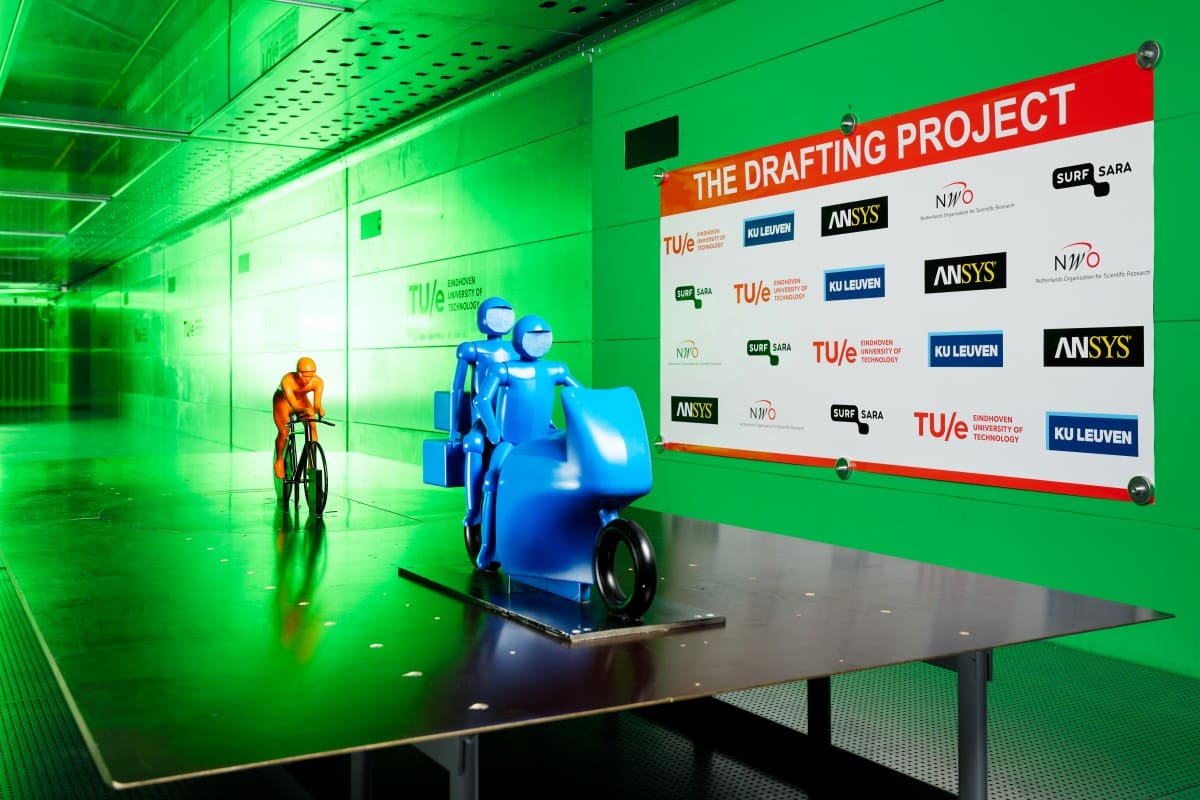
In almost every major cycling race in the past years, situations have occurred where cyclists have been drafting behind in‐race motorcycles. Although the International Cycling Union (UCI) has published new rules in 2017 to avoid such situations, these rules are not sufficient and are not strictly enforced. As a result, in almost every race, cyclists have substantially benefited from drafting behind motorcycles. Many cyclists, teams and commentators have complained about the aerodynamic benefits for drafting riders. However, up to now, it was not known how large these benefits are and for which distance between motorcycle and cyclist significant benefits still exist.
Professor Bert Blocken and his team at Eindhoven University of Technology (TU/e) in the Netherlands and KU Leuven in Belgium, in partnership with software company ANSYS, have investigated the aerodynamic benefits for cyclists caused by drafting behind motorcycles. Two methods have been used that, independently from each other, gave the same results. The methods were computer simulation (called: Computational Fluid Dynamics ‐ CFD) using ANSYS® Fluent™ software on the ANSYS Cloud and on the Dutch supercomputer Cartesius on the one hand and wind tunnel measurements in the new wind tunnel facility at TU/e at the other hand. The supercomputing work was supported by the Netherlands Organization for Scientific Research (NWO) and SURF Supercomputing.

Larger than expected
Blocken: “The aerodynamic advantages are larger than we expected. We first considered the reference situation of cycling on level road with no strong cross‐wind, head or tail wind. In this situation, a cyclist riding at 2.5 m behind a motorcycle has up to 48% less air resistance.” This
advantage decreases as the distance between motorcycle and cyclist gets larger, but at 10 m and 30 m distance, there is still up to 23% and 12% less air resistance, respectively. These values apply for all riding speeds.” These reductions in air resistance can be converted to potential time gains using cycling power models. For a TT cycling speed or high racing speed of 54 km/h, drafting at 2.5, 10 or 30 m can yield time benefits of 12.7, 5.4 or 2.6 seconds per kilometer. The advantages are also present for very long distances between motorcycle and cyclist. “Even at 50 m distance, there is still up to 7% less air resistance for the drafting rider.
In races where sometimes seconds or centimeters decide who wins and who loses the race, these differences are very large and can be decisive”, says Blocken. “The benefits mentioned above are experienced when drafting behind a single motorcycle.Often, there are more motorcycles and possibly cars which further increase the positive aerodynamic impact for the cyclists”,says Thierry Marchal, Global Industry Director for Sports
and Healthcare at ANSYS. He continues: “Similarly to traditional regulators practices in the aeronautic and automotive industries as well as in other motor sports, it is crucial that cycling authorities use all possible technologies, including engineering simulation, to better understand and quantify unexpected situations and take necessary decisions to ensure perfectly fair races.”
New rules
Dr. Fred Grappe, Performance Director of the Team Groupama‐FDJ confirms “as the performance in cycling is significantly linked to these aerodynamic effects, it is necessary to determine a “protected area” around the cyclist, inside which no motorcycle should penetrate more than a few seconds. Scientific studies such as this one are able to determine with accuracy this specific “protected area” which belongs alone to the cyclist. Knowing the importance of 1 second in a ranking, we can no longer ignore the importance of such a rule.”
Bert Blocken and his team earlier investigated the aerodynamic benefits for a cyclist when followed by a motorcycle and for a cyclist riding alongside a motorcycle. Although more counter‐intuitively, the computational simulations at that time were less demanding because of the shorter distances between motorcyclist and cyclists for which noticeable effects were found. For that project, supercomputing was not required, while for the present project, intensive supercomputing on both the ANSYS Cloud and the Dutch SURF Cartesius Supercomputer were necessary.







